Review
by Casey Brienza,Red Blinds the Foolish
GN
| Synopsis: |  |
||
The youthful Rafita Alonso is a rising star in the bullfighting ring, and his bright red costume has earned him the nickname, “The Red Matador.” But when he falls in love with Mauro, a colorblind butcher who renders the bulls Rafita kills for sale, his once supreme confidence begins to waver. Mauro reminds Rafita of a bull—he, like the bulls, is colorblind, and he has a scar by high right shoulder in exactly the place where a matador tries to land the final blow. Rafita starts having nightmares where he kills Mauro in the same way that he kills bull. Haunted by love and troubled with doubt, he makes a mistake in the ring. Could this finally be the end of his bullfighting career…or even his life? |
|||
| Review: | |||
To say that est em (all lowercase the way that the mangaka herself prefers it to be written) is to the boy's love genre as Ursula K. Le Guin is to science fiction, as translator Matt Thorn suggests in his lengthy endorsement on the back of the Deux Press edition of the manga, is a bit of an exaggeration. He was her former professor at Kyoto Seika University, and he is, as he himself acknowledges readily enough, biased. But he was only exaggerating a little. Her debut tankoubon Seduce Me After the Show, previously released in English by Aurora Publishing, was a bit uneven in spots, betraying the occasional narrative hesitancies of a novice, and she seemed not quite yet to have found a visual style that suits her fancy. Now in Red Blinds the Foolish, est em appears to have found her voice, both literally and metaphorically. The work as a whole is artistically coherent, thematically unified—and, every once in awhile, heartrendingly beautiful. Some say that Spanish is the language of love. I am not necessarily certain that est em would agree with that statement, but she certainly adores the romance of Spanish culture. In previous stories, she has explored the fiery passions of flamenco; in the title story of this volume, “Red Blinds the Foolish,” she unpacks the ritualized dance of death of the matador in the bullfighting ring and mirrors it against the intense feelings that Rafita and Mauro have for each other. Love between men is sometimes associated with the symbols and trappings of death because it does not, unlike heterosexual relationship, have reproductive potential. So believe it or not, but BL and bullfights actually harmonize quite well. And of course, the denouement involves Rafita's realization that he must be willing to kill even the man he loves—and that the man he loves is willing to die for him. This is the genre at its most decadent, at the pinnacle of its fascination with morbidity. Few mangaka do it like est em these days, and while tanbi (a.k.a. aestheticism) is tiresome in excess, in moderation it is a pleasurable indulgence. The rest of the short stories in Red Blinds the Foolish are more modest and less intensively researched. My favorite of the lot is “Baby, Stamp Your Foot,” about a shoemaker who finds a pair of high heels tucked away in his lover's closet. The heels are a memento of an adolescent's secret indulgences, and the shoemaker knows just what to do bring a bit of a the spice of youth into their love life. “Tiempos extra” features a relatively ordinary romance between the brother of a star soccer player and a security guard who staffed at the soccer field. The final story, “Lumiere,” is by far the weakest, and ambiguous tale of a man on his deathbed telling a tale of an aborted relationship between a dancer and his instructor. It is ambitious, but that ambition is hubris, and est em overreaches. The narrative ends up mired in the sneaking suspicion that something never got explained, and the characters feel overly ponderous in their pseudo-profundity. Clearly, the mangaka is still bumping up uncomfortably against her creative limits. Although she is exemplary when it comes to big-picture, unified themes and unusual, subtle shades of emotion. Everything is very gruff and understated, a woman's fantasy of masculinity. On the other hand, she still falters when attempting to take on too many layers of complexity. Fortunately, she seems to have found a visual style which suits her: a distinctive, instantly recognizable combination of mainstream manga's asymmetrical panel layouts and indie comics' bold black and white, improvisational lines. Most of the detail, as is common in both shoujo and BL, goes toward the human subjects. Backgrounds are minimal and only just enough to invoke exotic (a.k.a. non-Japanese) locales. All in all, est em is a talented artist who is unafraid of risk, and it is safe to expect ever greater things from this young mangaka in the future. |
| Grade: | |||
|
Overall : A-
Story : A-
Art : A-
+ A mangaka with great storytelling and artistic potential, occasionally realized here. |
|||
| discuss this in the forum (1 post) | | |||